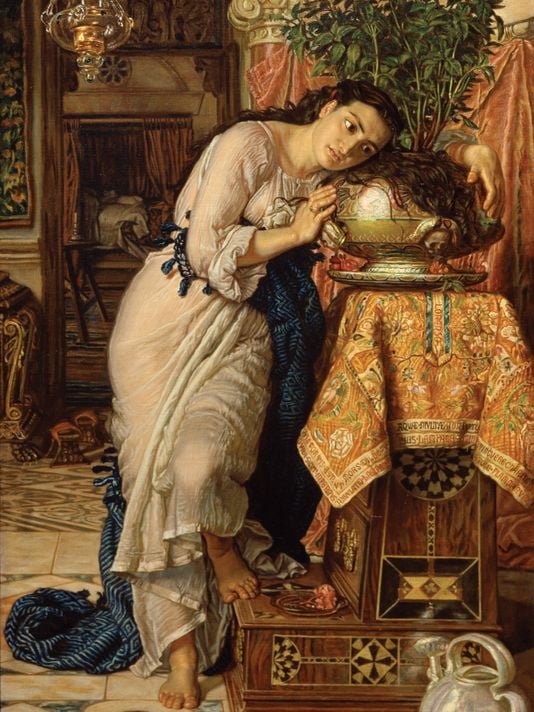Auctions
Delaware Art Museum’s Deaccessioned Masterpiece Bombs at Auction
Disappointing auction results imperil the institution's rescue plan.

Disappointing auction results imperil the institution's rescue plan.

The Delaware Art Museum‘s William Holman Hunt painting, Isabella and the Pot of Basil, failed to fetch even half of its low estimate at Christie’s London yesterday, reports Delaware Online. The sale of the 1868 canvas marked the museum’s first de-accessioning from its collection, as part of a desperate, last ditch effort to raise sufficient funds to keep the institution from closing.
Although Christie’s expected the pre-Raphaelite work to fetch between $8.4 million and $13.4 million, the bidding stalled out at a disappointing $4.25 million but sold nonetheless. The final price with premium was $4.9 million, still an auction record for the artist.
Works of art at auction are often unsold or “bought-in” when they fail to reach the “reserve” price, the undisclosed minimum at which the consignor agrees to sell it. In this instance, museum officials had already lowered their expectations on the official estimate based on their failure to attract a buyer in a private sale. The fact that the final price fell so far below the $8.4 million estimate suggests the reserve was quite low. The painting was headlining the auction house’s sale of Victorian, pre-Raphaelite, and British Impressionist art, and appeared on the cover of the accompanying catalogue.
As artnet News reported last week, there is good reason to believe that Delaware’s Alexander Calder mobile, Black Crescent, may also hit the auction block soon, as it is no longer on display at the museum and has been removed from the institution’s online database of its collection. Winslow Homer’s Milking Time has been similarly excised from museum records, and the museum is rumored to be shopping the painting around to potential buyers privately.
While the museum had initially announced plans to sell four pieces from its collection, it had also been hopeful to reach its $30 million goal with only three works. Now, because of the lower-than-hoped-for sales revenue from the Hunt work, it seems unlikely that that target will be reached without delving further into the Wilmington museum’s collection.
The Delaware Art Museum has already come under fire from the art community for its decision to liquidate part of its holdings, particularly from the Association of Art Museum Directors. This latest development seems certain to generate even more criticism of the financially foundering institution.
UPDATE: The Association of Art Museum Directors has released a new statement in response to the June 17 auction, deploring the museum’s sale of a work from its collection, disputing its claims that the only way for it to stay open is by selling its art, and calling on member institutions to cease all loans and collaborations with the Delaware Art Museum. The full statement is below:
The Association of Art Museum Directors is deeply troubled and saddened that the Delaware Art Museum has deaccessioned and sold a work of art from its collection to pay outstanding debt and build its operating endowment. Art museums collect works of art for the benefit of present and future generations. Responsible stewardship of a museum’s collection and the conservation, exhibition, and study of these works are the heart of a museum’s commitment to its community and to the public. It is therefore a fundamental professional principle that works can only be deaccessioned to provide funds to acquire works of art and enhance a museum’s collection.
AAMD does not agree that the Delaware Art Museum had only two options to address its current financial challenges—sell works from the collection or close the museum. Over the course of more than six months prior to this sale, AAMD reached out to the Delaware Art Museum’s leadership on multiple occasions in the hope that we could offer assistance in investigating alternatives to the planned sale—including helping the museum to campaign for private funding—in order to support the museum in upholding the highest professional standards. With this sale, the museum is treating works from its collection as disposable assets, rather than irreplaceable cultural heritage that it holds in trust for people now and in the future. It is also sending a clear signal to its audiences that private support is unnecessary, since it can always sell additional items from its collection to cover its costs.
By deaccessioning and selling a work from its collection to cover costs, the Delaware Art Museum has violated one of the most basic and important of AAMD’s principles. Therefore, AAMD has no choice but to sanction the Delaware Art Museum, since the actions of one institution can affect the entire field. Consistent with AAMD’s Code of Ethics, we ask our members to suspend any loans of works of art to, and any collaborations on exhibitions with, the Delaware Art Museum, until notified by us that the sanctions have been suspended or removed. While each of our members needs to consider this request individually and make its own decision, it is AAMD’s strong belief that the actions of the Delaware Art Museum are contrary to the long term interest of each and every art museum.